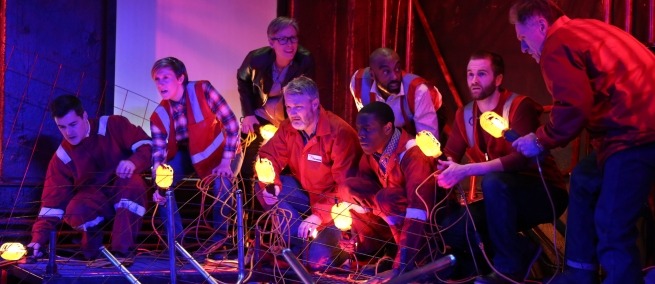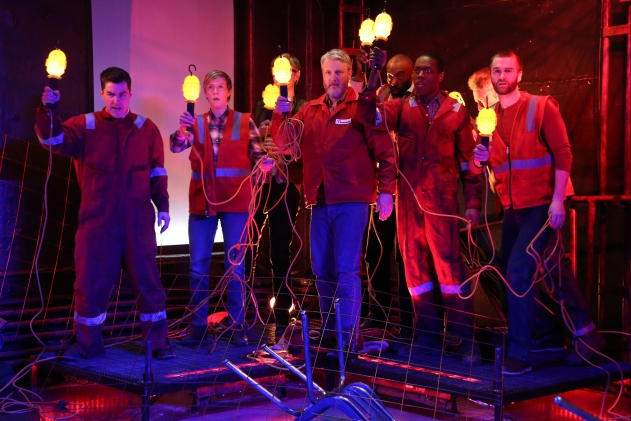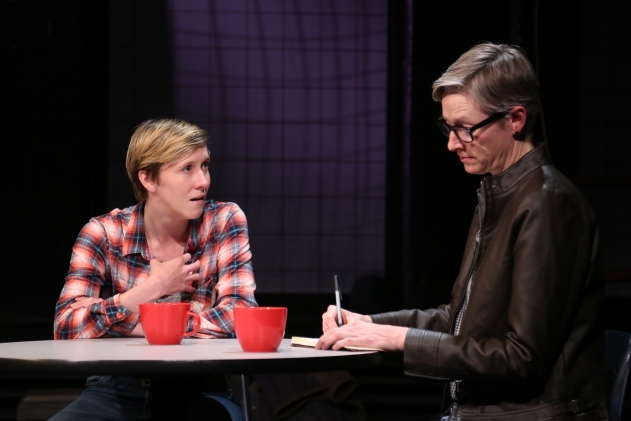
A new play about the environmental devastation and loss of lives caused by the Deepwater Horizon oil spill of 2010 is playing at the Ensemble Studio Theatre. Written by Leigh Fondakowski, SPILL stars eight actors who play a multitude of roles–from the playwright herself, to those she interviewed who lost loved ones when the rig exploded, to BP executives trying to stem the gush of oil ino the Gulf of Mexico. The play was developed over five years through the Ensemble Studio Theatre (EST)/Sloan Project, which has commissioned hundreds of new plays over the past two decades with support from the Alfred P. Sloan Foundation. Science & Film spoke on the phone with Fondakowski about SPILL.
Science & Film: Can you talk about the development of SPILL?
Leigh Fondakowski: The interesting thing about playwriting in America is that most of the time the playwright is expected to sit alone in a room and work on their play. Very rarely they have an audience. I have learned the most in the times I have had an audience. In the five years I was writing the play, the times I have had an audience in a staged environment, not just in a reading on music stands, has been five times. I have spent a lot of time on the page, but the play has grown and changed the most when an audience listens to it and responds. Because I’m not writing an essay, I am writing a play, there is only so much I can learn from the page until I see it in three dimensions.
S&F: Would you think about adapting the material you didn’t use for SPILL in another format?
LF: It could go in a book form for sure. I have used about ten percent of the material.
S&F: How did you decide what material from your research to include?
LF: Structurally, it is two distinct stories. It is the story of the rig blowing up, and then the story of the aftermath. All along the way people said, maybe you should just make it one or the other. I didn’t want to make it one or the other. The event did contain all those narratives. So, it’s really been about trying to strike a balance between overloading the audience with characters and information but also being true to what the actual event was. It was a messy, complicated, sprawling event that affected thousands upon thousands of lives.

S&F: Did anyone help you with the scientific and engineering content?
LF: I always had people check my work. I had an incredible dramaturge on the project, Sarah Lambert, who had the most thankless job. She read the House of Commons report which was about a thousand pages long, and she read the President’s report which was 400 pages long–and she gave me cliff notes. She has an incredible mind and helped me work my way through that material.
We wanted to have more of the engineering story in the play, but I think it was hard for the audience to understand. Writing the play was about finding that balance. I would ask people in the theater, why did the rig blow up? They would say, they got the test wrong. Or, they cut corners to the point where it blew up. As long as they had a basic understanding that was enough for me. Deepwater Horizon was not like the space shuttle accident where just the O-ring went wrong. There were 20 different things.

S&F: How did you first decide this was a story you wanted to tell?
LK: I was co-teaching a class at Wesleyan University with a scientist, and was asked to take a group of students down to Louisiana after the oil spill. She taught them the science and I taught them the interviewing methods. I thought it was going to end there. But when I got down there the woman who got me involved said, maybe there’s a play you want to write. She said she would support me and give me a bit of money. Then, I quickly hooked up with EST and the Sloan fellowship and they supported the rest of the play. I also raised some money on my own. It was a very expensive, labor-intensive process to make trip after trip. Sometimes you make a trip but the stars don’t align and you don’t get much material, so then you have to go back.
I got hooked on that first trip because I had never been to the Bayou; I had never been to Southern Louisiana, and I had no grasp of how magnificent the place is and how culturally complex and interesting it is. I had never been to a place where the cultural identity was linked with an industry. You have boats and dolphins, and then all around there are industrial machines and giant structures. It was very jarring. I got drawn in to telling the story of a place where oil and nature seemingly run hand in hand, and then there was catastrophic event and the story that they told of themselves began to fracture.

S&F: In the play, you have great videos of the oil spewing underwater. Are those real?
LK: Yes. The videos were from the government. I was so impressed by the video designer David Bengali. He searched around, contacted the right people, and got the rights.
S&F: Did you think about your work as science-related before SPILL?
LK: I never really thought about my plays as science plays. I have always held myself to a high ethic, but then having the science ethic on top of it has been interesting. The EST/Sloan people hold their plays to a very high standard; they need things to be vetted and accurate. I really respected that. I think I would still have done due diligence, but it was interesting to know that the institution that was supporting the work really cared about being accurate. Having Sloan behind us legitimizes the work. People know I’m not making anything up.
SPILL runs through April 2nd at the Ensemble Studio Theatre in Hell’s Kitchen. It is written and directed by Leigh Fondakowski, and stars Michael Cullen, Vince Gatton, Alex Grubbs, Ronald Peet, Molly McAdoo, Maurice McRae, Kelli Simpkins, and Greg Steinbruner. EST is run by Artistic Director William Carden, Associate Artistic Director Graeme Gillis, and Director of New Play Development Linsay Firman. The EST/Sloan Project has given over $3 million in grants to playwrights.
Photo credits: Gerry Goodstein
TOPICS